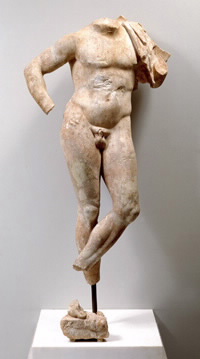In the fall of 1979, I was teaching Huckleberry Finn and The Great Gatsby in spacious classrooms on the second floor of the University of Tehran, without actually realizing the extraordinary irony of our situation: in the yard below, Islamist and leftist students were shouting Death to America,
and a few streets away, the U.S. embassy was under siege by a group of students claiming to follow the path of the imam.
Their imam was Khomeini, and he had waged a war on behalf of Islam against the heathen West and its myriad internal agents. This was not purely a religious war. The fundamentalism he preached was based on the radicla Western ideologies of communism and fascism as much as it was on religion. Nor were his targets merely political; with the support of leftist radicals he led a bloody crusade against Western imperialism
: women’s and minorities’ rights, cultural and individual freedoms. This time, I realized, I had lost my connection to that other home, the America I had learned about in Henry James, Richard Wright, William Faulkner, and Eudora Welty.
In Tehran, the first step the new regime took before implementing a new constitution was to repeal the Family Protection Law which, since 1967, had helped women work outside the home and provided them with substantial rights in their marriage. In its place, the traditional Islamic law, the Sharia, would apply. In one swoop the new rulers had set Iran back nearly a century. Under the new system, the age of marital consent for girls was altered from eighteen to nine. Polygamy was made legal as well as temporary marriages, in which one man could marry as many women as he desired by contract, renting them from five minutes to ninety-nine years. What they named adultery and prostitution became punishable by stoning.
Ayatollah Khomeini justified these actions by claiming that he was in fact restoring women’s dignity and rescuing them from the degrading and diabolical ideas that had been thrust upon them by Western imperialists and their agents, who had conspired for decades to destroy Iranian culture and traditions.
In formulating this claim, the Islamic regime not only robbed the Iranian people of their rights, it robbed them of their history. For the true story of modernization in Iran is no that of an outside force imposing alien ideas or–as some opponents of the Islamic regime contend–that of a benevolent shah bestowing rights upon his citizens. From the middle of the nineteenth century, Iran had begun a process of self-questioning and transformation that shook the foundations of both political and religious despotism. In this movement for change, many sectors of the population–intellectuals, minorities, clerics, ordinary people, and enlightened women–actively participated, leading to what is known as the 1906 Constitutional Revolution and the effective implementation of a new constitution based on the Belgian model. Women’s courageous struggles for their rights in Iran became the most obvious manifestation of this transformation. Morgan Shuster, an American who had lived in Iran, even stated in his 1912 book, The Strangling of Persia: The Persian women since 1907 had become almost at a bound the most progressive, not to say the most radical, in the world. That this statement upsets the ideas of centuries makes no difference. It is the fact.
By 1979, at the time of the revolution, women were active in all areas of life in Iran. The number of girls attending schools was on the rise. The number of female candidates for universities had increased sevenfold during the first half of the 1970s. Women were encouraged to participate in areas previously closed to them through a quota system that offered preferential treatment to eligible girls. Women were scholars, police officers, judges, pilots, and engineers–present in every field except the clergy. In 1978, 333 out of 1,660 candidates for local councils were women. Twenty-two were elected to the Parliament, two to the Senate. There was one female Cabinet minister, three sub-Cabinet undersecretaries (including the second-highest ranking officials in both the Ministry of Labor and the Ministry of Industries), one governor, one ambassador, and five mayors.
After the demise of the shah, many women, in denouncing the previous regime, did so demanding more rights, not less. They were advanced enough to seek a more democratic form of governance with rights to political participation. From the very start, when Islamists attempted to impose their laws against women, there were massive demonstrations, with hundreds of thousands of women pouring into the streets of Tehran protesting against the new laws. When Khomeini announced the imposition of the veil, there were protests in wihch women took to the streets with the slogans: Freedom is neither Eastern nor Western; it is global
and Down with the reactionaries! Tyranny in any form is condemned!
Soon the protests spread, leading to a memorable demonstration in front of the Ministry of Justice, in which an eight-point manifesto was issued. Among other things, the manifesto called for gender equality in all domains of public and private life as well as for the guarantee of fundamental freedoms for both men and women. It also demanded that the decision over women’s clothing, which is determined by custom and the exigencies of geographical location, be left to women.
Women were attacked by the Islamic vigilantes with knives and scissors, and acid was thrown in their faces. Yet they did not surrender, and it was the regime that retreated for a short while. Later, of course, it made the veil mandatory, first in workplaces, then in shops, and finally in the entire public sphere. In order to implement its new laws, the regime devised special vice squads, called the Blood of God, which patrolled the streets of Tehran and other cities on the lookout for any citizen guilty of moral offense.
The guards could raid shopping malls, various public spaces, and even private homes in search of music or videos, alcoholic drinks, sexually mixed parties, and unveiled or improperly veiled women.
The mandatory veil was an attempt to force social uniformity through an assault on individual and religious freedoms, not an act of respect for traditions and culture. By imposing one interpretation of religion upon all its citizens, the Islamic regime deprived them of the freedom to worship their God in the manner they deemed appropriate. Many women who wore the veil, like my own grandmother, had done so because of their religious beliefs; many who had chosen not to wear the veil but considered themselves Muslims, like my mother, were now branded as infidels. The veil no longer represented religion but the state: not only were atheists, Christians, Jews, Baha’is, and people of other faiths deprived of their rights, so were the Muslims, who now viewed the veil more as a political symbol than a religious expression of faith. Other freedoms were gradually curtailed: the assault on freedom of htep ress was accompanied by censorship of books–including the works of some of the most popular classical and modern Iranian poets and writers–a ban on dancing, female singers, most genres of music, films, and other artistic forms, and systematic attacks against the intellectuals and academics who protested the new means of oppression.
In a Russian adaptation of Hamlet distributed in Iran, Ophelia was cut out from most of her scenes; in Sir Laurence Olivier’s Othello, Desdemona was censored from the greater part of the film and Othello’s suicide was also deleted because, the censors reasoned, suicide would depress and demoralize the masses. Apparently, the masses in Iran were quite a strange lot, since they might be far more demoralized by witnessing the death of an imaginary character onscreen than being themselves flogged and stoned to death …. Female students were reprimanded in schools for laughing out loud or running on school grounds, wearing colored shoelaces or friendship bracelets; in the cartoon Popeye, Olive Oyl was edited out of nearly every scene because the relationship between the two characters was illicit.
The result was that ordinary Iranian citizens, both men and women, inevitably began to feel the presence and intervention of the state in their most private daily affairs. The state did not merely punish criminals who threatened the lives and safety of the populace; it was there to control the people, to flog and jail them for wearing nail polish, Reebok shoes, or lipstick; it was there to watch over young girls and boys appearing in public. In short, what was attacked and confiscated were the individual and civil rights of the Iranian people.
–Azar Nafisi, The Stuff that Dreams are Made Of, in My Sister, Guard Your Veil; My Brother, Guard Your Eyes: Uncensored Iranian Voices (2006; ISBN 0807004634), pp. 2–6.

